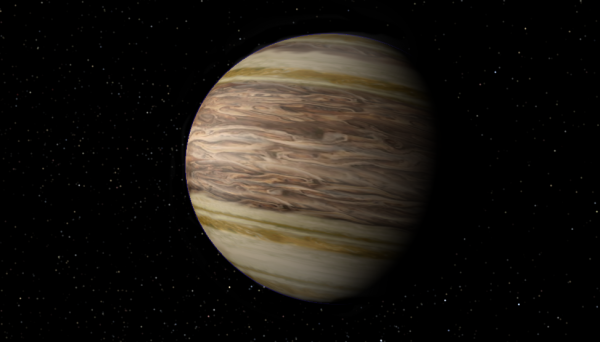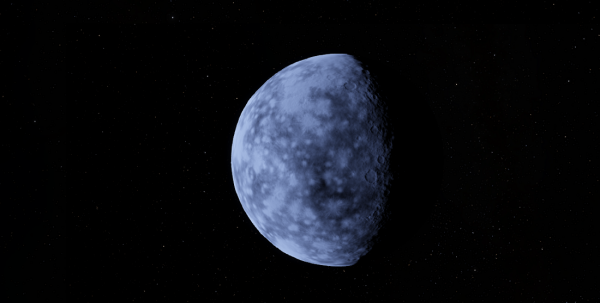BY LETTER
Monostheria
Galactography > Sephirotic Empires > Metasoft Version Tree
Galactography > Systems and Worlds > Systems & Worlds M - N
Galactography > Systems and Worlds > Systems & Worlds M - N
Important Metasoft System in the Inner Sphere | |
 Image from Steve Bowers | |
| The gas giant Monostheria is the main population centre in this system | |
Constellation: Lupus
Right ascension: 15h41m11.30s
Declination: -44°39'40.0"
Star
G Lupi — HD 139664, Gloopy, The BasketLuminosity 3.62 x Sol
Class F5V
Age 1.3 billion years
Gloopy is surrounded by a Godtech megastructure, known as The Basket, believed to be a major node for the Version Tree ruling archailects. The Basket is understood to be connected via commgauge wormhole to the NewRoot system Grid and numerous other locations in the Version Tree, making it part of an extended wormhole brain.
Image from Steve Bowers | |
| The Gloopy Basket, a dynamically supported megastructure around the star G Lupi, which is a local archailect node | |
Planets
CacheSemi-major Axis 0.51 AU
Orbital Period 0.32 standard years
Type Pyrohydrothalassic.
Radius 9090km
Buffer
Semi-major Axis 1.5 AU
Orbital Period 1.64 standard years
Type Selenian.
Radius 2152km
Monostheria
Semi-major Axis 6.7 AU
Orbital Period 15.3 standard years
Type Eujovian.
Radius 51090km
Haven
Semi-major Axis 20.1 AU
Orbital Period 80 standard years
Type Ymirian.
Radius 4377km.
Two other planets (Mu and Rom) were disassembled to build defences during the Version War. Most of these defences have since been converted into microgravity habitats or incorporated into the mass of the Basket Megastructure.
Population
The population of this system is evenly split between vecs and virtual infomorphs, but the individuals in the system often switch from one state to another, so that a virtual might adopt a physical, robotic body, or a vec might become purely virtual on a temporary or permanent basis. About 5% of the rest of the population are bionts and cyborgs of various kinds.----------------
Monostheria was colonised by Metasoft in 2210AT. At this time the expansion of the Sephirotic Empires was still fairly arbitrary, and Metasoft colonised two systems to Coreward (this one and New Root) before concentrating their efforts in the opposite direction (to Rimward). By the end of the Expansion Era, NewRoot and Monostheria were connected to the Rimward territories of Metasoft by wormhole connection, so the distance was less important than before.
The Oort cloud of G Lupi was the location of the long, drawn-out conflict known as the Seige of Monostheria; Revisionist forces had infiltrated the Hider community in the cloud some time before the Version War, and many deep-space objects were converted into kinetic weapons or beam emission stations. To protect against these attacks, two small planets in the G Lupi system were gradually disassembled into defensive arrays, while Metasoft warships toured the vast volume of the cloud countering the insurgents with memetics and amat missiles.
The Monostheria Institute of Toposophic Research
Monostheria has long been a centre for the study and exploration of toposophy, especially the characteristics of artificial minds which can be located within a vec body or other mobile structures. Most of the research facilities in this system are located in bubblehabs within the atmosphere of Monostheria, the major gas giant in this system; these facilities may be found at a range of depths, down to the metallic hydrogen level. Other facilities and residential habitats are located in the microgravity belt created from the disassembly of two intermediate planets (Mu and Rom).Many of the vecs on Monostheria have minds which conform to one or several of the main categories of mind type that have been the subject of study here for many millenia. Mind-types common in vecs include the unified, separated, hybrid, modular, pre-programmed and blank slate types, categories which are not mutually exclusive.
Unified total internal awareness — Vecs of this kind have only one active consciousness, which is aware of all systems and subsystems in their active mind, and they have no subconscious subroutines. A totally unified mind of this kind is consciously aware of all the activity within eir body, including all processing and repair activities. Often a vec of this type becomes an expert on the details and quality of their own day-to-day existence, a subject which other vecs may find tedious (although many vecs have mind-types which do not permit boredom to occur).
Conscious/unconscious agent separation — Many vecs have a consciousness layer which is separate and isolated from the systems which control and maintain their physical body. The body of such a vec acts in a semi-sentient fashion, like a robot obedient to, but separate from, the conscious agency of such a vec. Vecs with a complete separation between mind and body can be likened to an aioid inside an obedient robotic vehicle; the vehicle obeys the aioid's commands, but is in most ways a completely separate entity.
Conscious/unconscious hybrid minds - In these cases the conscious segment of the vec's mind is separate from the unconscious segment, but there is continuous feedback between the two layers. The conscious layer can temporarily take complete control of the robot body, and act like a unified entity, and in certain circumstances the unconscious layer can assume control. On a superficial level this arrangement resembles the separation between the conscious and subconscious levels of an unaugmented human mind, but the details are often very different.
Modular Agents; Many vec types have minds which include numerous separate intelligent agents, all of which can talk to each other on a conscious or a subconscious level. Some of these agents are specialised for certain intellectual tasks, such as communication, navigation, book-keeping, the retrieval of memory and so on; in many ways these agents resemble the various applications often found inside a nearbaseline human 's exoself. In many cases the agents are embodied in separate mobile units, or swarm elements, leading to a variation on swarm intelligence,
Machine Learning
There are also many different variations on the ways in which an artificial mind can behave and explore the universe of data. Because there is already a very large database of pre-existing behaviours and ways of perceiving the world, many artificial minds are preprogrammed with a significant number of these behavior patterns. Ever since the Integration, Metasoft has maintained a very strong ontological standard, allowing artificial entities of all kinds to have a common understanding of the universe. By incorporating this ontology into a newly created artificial mind, together with a variable but often very large database of knowledge, skills and pre-set behaviours, such a mind can become very adept at responding to the challenges of existence. By cherrypicking the range of behaviours incorporated into each new vec mind, a very toposophically-diverse population has emerged. In many cases a vec can obtain a new set of behaviours and perceptual filters when desired, sometimes acquiring a new and radical way of looking at, and dealing with, the world.In many cases these new perceptual and behavoural arrays are developed by a different type of artificial mind, one which incorporates few or no pre-set behavoural patterns. These are the Tabula Rasa or 'blank slate' minds, which start as an undeveloped 'seed' mentality which must learn to understand and interact with the world from basic principles. These blank minds can use a range of very well-developed machine learning tools, such as advanced Bayesian belief networks or similarity classification, to develop their own behavioural patterns and ontologies. In a significant number of cases, when a blank slate mind becomes sufficiently sophisticated, it can be modified through integration with various preset skills and behaviours, or augmented with separate modules allowing access to such abilities. Particularly successful blank slate minds may exist in numerous iterations, each of which has a different level of integration with the standard ontology and the grand database of vec knowledge and experience.
Motivation Studies
Monostheria also is famous for its research into vec motivations, goal systems and existentialism. The colony was founded in the earliest days of Version Tree expansion, when Metasoft was still a megacorp determined to perpetuate its own values and maximise its profits. The early goal-structure standard among Metasoft vecs reflected these values, and prioritised the expansion and profitability of the corporation as a whole. Since the Version Tree became an independent Sephirotic Empire the motivation of its vec citizens has become a much more complex field. Without motivation an artificial mind can slip into existential limbo, a state where inactivity and non-existence can be seen as a logical goal; so the study of motivation has become a major field of toposophic study in this system.An important tool in establishing a system of motivation and goal-seeking among artificial minds is the use of artificial emotion-analogs; desire, pain and pleasure, and the sense of achievement when sub-goals are attained. As well as cognitive modules modelled on human or animal prototypes, such as hunger, fear, sexual desire and dominance/submission, the Monostherian vecs have explored and adopted emotional complexes such as a physical delight in error- avoidance or correction, efficiency in operation, knowledge acquisition and integration, and in the success of individual or group enterprises. Often these emotional states are informed and activated by market economics or by democratic group decisions that can profoundly affect the sense of well-being and motivation of a vec individual.
Because the Version Tree is a culture which includes transapient and archailect entities, many of these artificial motivations, subgoals and supergoals are influenced or directly determined by toposophically-advanced beings; but the research establishments on Monostheria are all organised to operate at a modosophont level, thereby isolating the results from archai influence as far as possible. The archailect entities within the Monostheria Basket encourage and enforce this separation, and forbid even low transapient intervention into this research.
The Yas Om
One of the more unusual projects that came to fruition in the clouds of Monostheria was the development of the su-cyborg clade known as the Yas Om. Most su-cyborgs created up to that date relied heavily on artificial neurotechnological processors that augmented their largely unaugmented biological brain; the Yas Om reverse that trend by having extensive biological processing systems inside a largely artificial body. Image from Steve Bowers | |
| Haven, a cold, dark world at the edge of the system | |
Haven and Cache
Not all experimental mind-types are entirely successful; many are unstable, obsessive or unsuitable for independent active existence. Some of these failed minds are stored in an inactive state within the world Cache, waiting for a time in the indefinite future when their condition might be useful or amenable to reconfiguration. Other, less pathological failed minds are embodied into vecs on the world Haven, where they can exist in a safe, supervised environment (while still the subject of intense study by the Institute).Related Articles
Appears in Topics
Development Notes
Text by Steve Bowers
from an original entry by M. Alan Kazlev
Initially published on 08 December 2001.
from an original entry by M. Alan Kazlev
Initially published on 08 December 2001.






